|
Simplex Manufacturing Company in World War Two
New Orleans, LA
1935-1975
This page updated 9-17-2024.
Simplex Manufacturing Company was formed in
1935 by Paul Treen to make a light-weight motorcycle. This was the
Servi-Cycle which was produced until the mid-1950s. After that, the
company made mini-bikes and go-karts until 1975, using engines of its
own design.

Mr. Paul Treen was the inventor of the Servi-Cycle,
which he began developing in 1928. The primary reason he invented
the Servi-Cycle was to provide a method of low-cost, dependable
transportation. He also realized that in order to do this, he
required a modern factory with the best equipment available. The
outside of just such a factory is shown in the next photo. The
photo above and the factory photo below are from an undated Servi-Cycle
sales brochure which is most likely a post-World War Two document.
This document gives the only known view of the methods used to
manufacture the Servi-Cycle. There are more photos of the plant
operation at the bottom of this page.
Between 1928, when Mr. Treen first designed the
Servi-Cycle and when production began in 1935, Mr. Treen had to overcome
some obstacles. A year after he designed the Servi-Cycle, the
stock market crashed and eventually the country and the world entered
the Great Depression. Somehow, during this time he was able to
find investors to raise the cash needed to buy the necessary tools and
machines, build or lease a factory, and then hire and meet payroll for
his employees. How he did this has been lost to history.
However, the Simplex Manufacturing Company was able to begin business
during the Depression with a new product to help persons with their
transportation needs. This in itself was a huge accomplishment for
the times.

The Simplex factory in New Orleans was a
block long. It's address was 540 North Carrollton Ave.
Mr. Treen saw to it that the factory and its offices were
air-conditioned for the benefit of the employees. A constant
temperature also allowed for more accuracy in machined parts. The
factory also had "occupational" music played in the plant. Photo
added 9-1-2022.

The factory was razed after Simplex went out
of business and the area re-developed into a shopping area. This
Google Maps street view shows the same area today. With the
newness of the buildings, it appears that the factory was razed in the
recent past. Photo added 9-1-2022.
Simplex Manufacturing Company World War Two Production: The
company only had one major contract for its Servi-Cycles used by
paratroopers in World War Two. The 652 Servi-Cycles were
built at a unit cost of $258.59. Most likely the company
engaged in subtracting work for other companies in New Orleans such as
Higgins Industries.
Table 1 - Simplex Manufacturing
Company's Major World War Two Contracts
The information below
comes from the "Alphabetical Listing of Major War Supply
Contracts, June 1940 through September 1945." This was
published by the Civilian Production Administration,
Industrial Statistics Division. |
|
Product |
Contract Amount |
Contract Awarded
|
Completion
Date |
|
Bicycles, Motor Driven |
$136,000 |
5-1943 |
9-1943 |
|
Total |
$136,000 |
|
|
Table 2 -
Simplex Manufacturing Company Bicycles, Motor Driven
Accepted by Detroit Ordnance, US Army
The information below comes from "Summary Report of
Acceptances, Tank-Automotive Material, 1940-1945."
Published by Army Services Forces, Office, Chief of
Ordnance-Detroit, Production Division, Requirements and
Progress Branch,
January 21, 1946. |
|
Type |
1940 |
1941 |
1942 |
1943 |
1944 |
1945 |
Total |
Bicycles, Motor
Driven
(Servi-Cycles) |
|
|
152 |
500 |
|
|
652 |
|
Table 3 -
Simplex Manufacturing Company Products
Information in this table was provided by Alex Schmidt.
Table added 8-29-2022. |
| Model
Type |
Dates
of Production |
|
Prototypes |
1933, 1934, 1935 |
| 1935
Model |
11-1935 through 4-1936 |
| 1936
Model |
5-1936 through late 1936 or early 1937 |
| 1937
Model |
Late
1936 or early 1937 through 9-1937 |
| 1938
Model |
10-1937 through late 1938 or early 1939 |
| 1939
Model |
Late
1938 or early 1939 through late 1939 or early 1940 |
| 1940
Model |
Late
1939 or early 1940 through 3-1940 |
| G
Model |
4-1940 through 12-1944 |
| H
Model |
1-1945 through 9-1947 |
| 48
Model |
10-1947 through 8-1948 |
| J
Model |
9-1948 through 1-1949 |
| K
Model |
2-1949 through 6-1949 |
| L
Model |
7-1949 through 12-1951 |
| M
Model |
1-1952 through late 1960 |
|
Scooters and Go-Karts |
Early
1961 through early 1972 |

In March 2022, I photographed this Simplex
Manufacturing Company-built Servi-Cycle at the National Museum of World
War Two in New Orleans, LA. I was surprised to see this as it had
not been on display when I previously visited the museum in 2017.
Also, until I saw this display I was unaware that American paratroopers
used this type of vehicle in World War Two. Therefore, this was a
new discovery for me and was one of several new things I learned on my
repeat visit to the Museum.
Mr. Dave Johnson of New Orleans restored this
vehicle for the owner, who has loaned it to the museum for display.
Mr. Johnson has verified that this unit was built in 1945. This is
because it has an "H" serial number. This particular unit has
crash bars, indicating it may have been built after the war ended.

It is hard to see in this photo, but
the first letter is an "H." The serial number on the vehicle is
H6269. Author's photo added
8-29-2022.

This image shows Servi-Cycle H6269 in Mr.
Dave Johnson's shop at the beginning of his restoration. Image
courtesy of Mr. Dave Johnson added 9-17-2024.
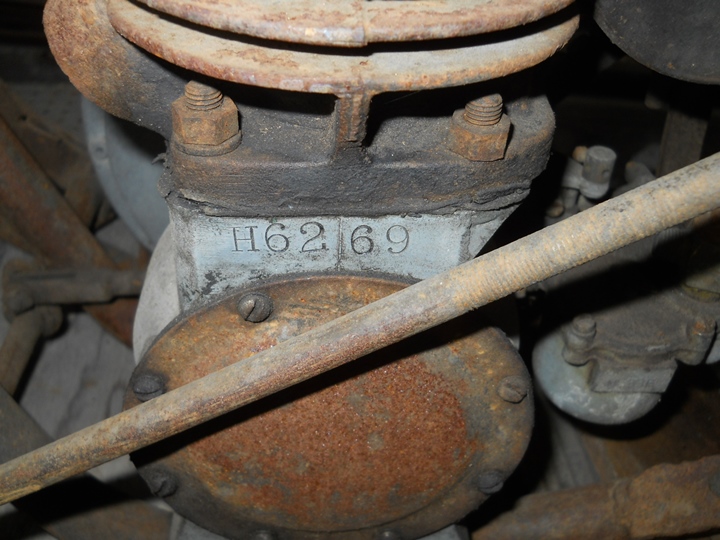
This image clearly shows the "H" in
the serial number. Image courtesy of Mr. Dave Johnson added
9-17-2024.
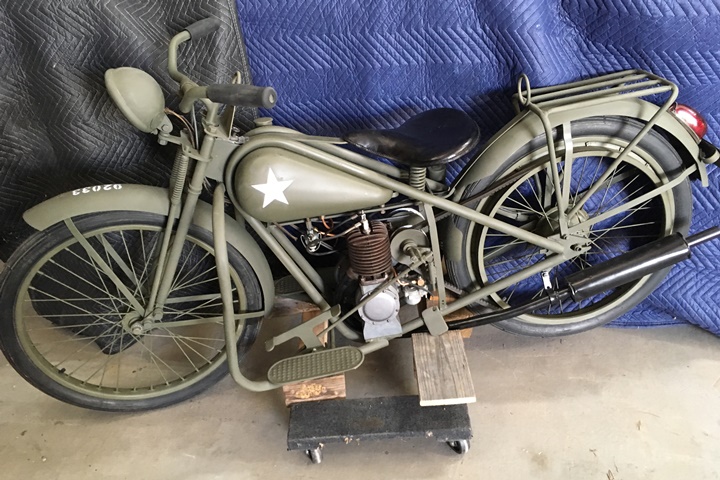
Restoration complete! Image
courtesy of Mr. Dave Johnson added 9-17-2024.

Mr. Johnson advised me that the
United States Army Air Forces purchased Servi-Cycles for post-war bomber
crews to assist in traveling the long distances at air force bases.
This may well have been one of those. Image courtesy of Mr. Dave
Johnson added 9-17-2024.

Since my last visit, the National Museum of
World War Two has added a special display of Louisiana companies that
contributed to the winning of World War Two. Included in the
display is the Servi-Cycle H6269. Image courtesy of Mr. Dave
Johnson added 9-17-2024.

This photo is part of the information
from the Servi-Cycle placard at the National Museum of World War Two.
It shows Chaplain Francis L. Sampson of the 501st Parachute Infantry
Regiment on a G-A-1 Servi-Cycle in Holland. Note that the G-A-1
does not have the crash guard on it. Image added 8-29-2022.

This photo was taken on September 17, 1944,
as these paratroopers and C-47 aircrew wait to load for Operation Market
Garden. A G-A-1 Servi-Cycle is in the photo. Photo added
8-29-2022 courtesy
of Alex Schmidt.
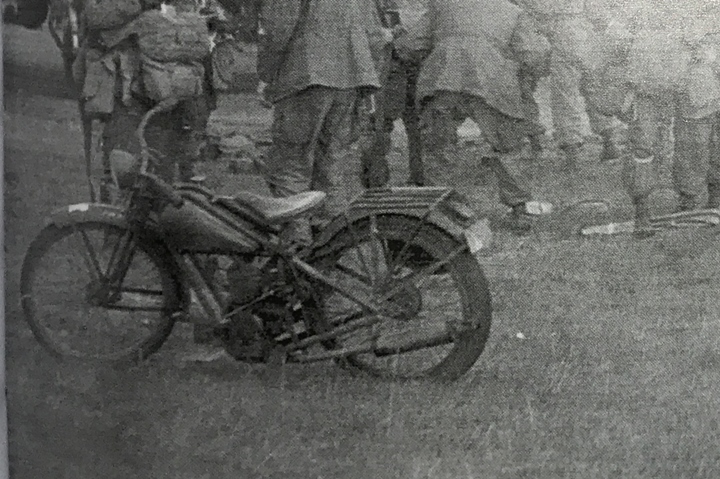
The vehicle does not have a crash guard.
Photo added 8-29-2022 courtesy of Alex Schmidt.
Mr. Alex Schmidt has also provided me with
information on the Servi-Cycle. According to his research, there are
only two known G-A-1s still in existence. He owns one which is
waiting to be restored and the other is at the Dead Mans' Corner Museum
in France. Below are eight photos of this vehicle courtesy of Alex
Schmidt of the Dead Man's Corner Museum's G-A-1. These were all
added 8-29-2022.

There is no crash guard on this unit.





The G-A-1 Servi-Cycle was powered by a
2-stroke engine that had a range of 250 miles on 2.5 gallons of
gasoline. It had a top speed of 30 miles per hour. The
engine had twin sparkplugs and had a Simplex-designed magneto for the
dual ignition system.



This 1949 "Chief" Servi-Cycle is on display
at the Gilmore Car Museum in Hickory Corners, MI. Author's photo
added 9-14-2024.

Author's photo added 9-14-2024.

Author's photo added 9-14-2024.

Author's photo added 9-14-2024.
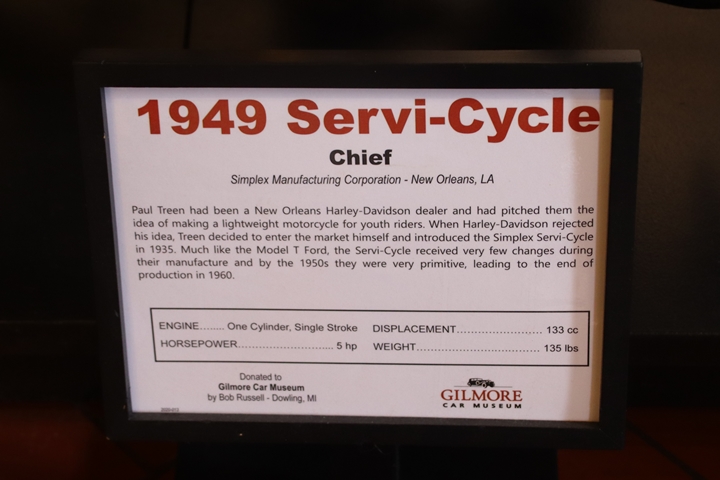
Author's photo added 9-14-2024.
The several pages from the manual for the
G-A-1 below were also provided by Mr. Alex Schmidt and added 8-29-2022.


The photo from the manual shows that there
is no crash guard on the G-A-1.

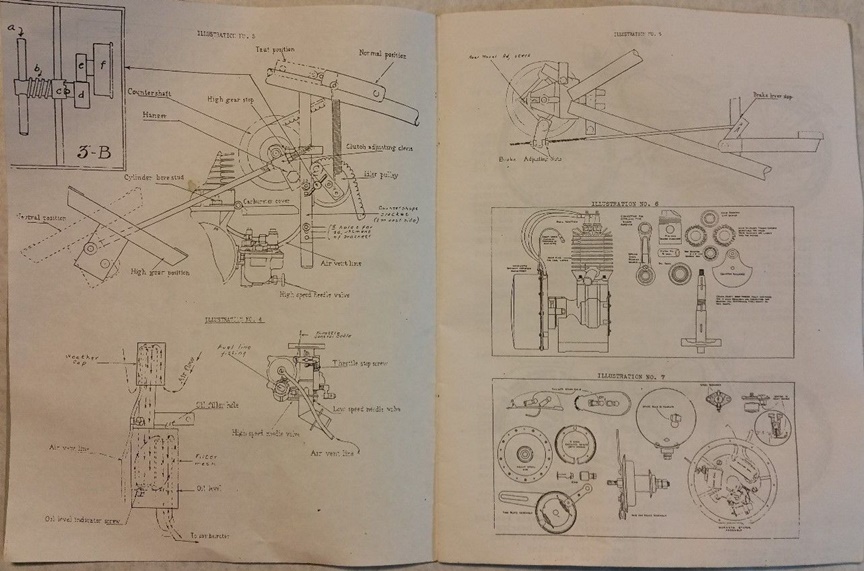
Post-World War Two Simplex Manufacturing
Company Military Servi-Cycles:
Interestingly enough, the day before I
received Mr. Schmidt's July 2022 email, I was at the National Museum of
the Mighty Eighth Air Force in Pooler, GA. While there I
photographed a Servi-Cycle on display under the wing of the Museum's
B-17. I was able to determine that this was a 1953
unit because of the date on the data plate. This data plate also
indicates this unit was purchased by the U.S. Army.

Author's photo.

Note the Army Ordnance inspector's stamp and
the date of August 1953. This shows that the U.S. Army purchased a
number of these in the 1950s. This is serial number M138835
indicating that the Army was buying the standard commercial M model.
It is Ordnance type ORD-16697.
The Simplex Manufacturing Process:
The undated Servi-Cycle sales manual was used to show the
manufacturing process to prospective distributors, such as bicycle and
motorcycle shops, so they would know they would be selling a quality
product to their customers. The sales manual is the only known
information available on this unique company's product. All of the
photos below were added 9-1-2022.

This is the machine shop. Note the
speakers on the wall to play "occupational" music.

Farther along the wall these operators are
machining cylinder heads.

In this operation, the worker is bending the
leg-guard from one inch steel tubing. This operation was not
required for World War Two G-A-1 model for the U.S. Army.

In the welding shop, the frames of the Servi-Cycles
are welded. There is a speaker mounted to the wall to play music.

The frame is being welded Inside a welding
booth.

Once the frames are welded, they are run
through a paint dip tank while hanging on a conveyor. Then they go
through the infra-red heat lamps of the drying oven which dries the
parts in eight minutes.

In final assembly, twenty different
subassemblies come together to make a Servi-Cycle.

The plant has at least three final assembly
lines.

Once the Servi-Cycles come off the final
assembly line, they are put on one of the two dynamometers shown at the
back of the room. Here they are run up to full speed and given a
full functional testing of all of the systems. Any repairs that
are needed are made by the two repairmen in the foreground. These
would have been the most experienced mechanics in the factory.

When the process is complete, another Servi-Cycle
is ready to ship to the customer. This appears to be a base unit
as it does not have a leg guard on it. The rear tire also needs
some air.

Or one could purchase the super-deluxe model
with lots of chrome parts and saddle bags with fringe. This one even
has the tires pumped up.

In 1947 a standard Model H cost $278.25 and
a deluxe mode $300.
The Model H came out before I was born.
However, later models were produced while I was a youngster and going to
grade school. I think I remember seeing teenagers in the
neighborhood driving Servi-Cycles on the streets.

In 1964 both The Beach Boys and The Hondells
had hits with the song "Little Honda." The arrival of Japanese
motorcycles and the sales they generated in the United States may well
have played a part in the demise of the Simplex Manufacturing Company
and the Servi-Cycle. This 1966 Honda 50 is on display at the
Gilmore Car Museum. Author's photo added 9-17-2024.
|












































